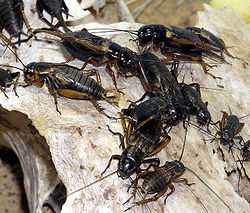Gryllus bimaculatus
| Gryllus bimaculatus | |
|---|---|
 | |
| Gryllus bimaculatus | |
| Scientific classification | |
| Kingdom: | Animalia |
| Phylum: | Arthropoda |
| Class: | Insecta |
| Order: | Orthoptera |
| Suborder: | Ensifera |
| Family: | Gryllidae |
| Genus: | Gryllus |
| Species: | Gryllus bimaculatus |
| Binomial name | |
| Gryllus bimaculatus De Geer, 1773 | |
Gryllus bimaculatus is one of many cricket species known as the field cricket. Also known as the African or Mediterranean field cricket or as the two-spotted cricket, it can be discriminated from other Gryllus species by the two dot-like marks on the base of its wings.
This species of cricket is popular for use as a food source for insectivorous animals like spiders and reptiles. They are easy to raise and do not require prolonged exposure to cold temperatures in order to complete their life cycle.
Behaviour
Fighting
In the wild, male crickets tolerate one another and will fight until there is a winner. The loser usually retreats without serious injury. The fighting method involves opening the mandibles as wide as possible, gripping onto the opponent's mandibles and pushing with the hind legs. There is a strange behavior involved in fighting- this activity seems to trigger its fighting spirit.
Chirping
Male crickets of this species produce several distinctive chirps, though each sound is made by rubbing the two outer wings together. Loud and steady chirps made throughout the night are to attract females and to warn off other males. Loud fast-fequency chirps are emitted when males encounter one another and are preparing to fight. They are intended to frighten off the rival male. A soft clipping sound is made when a female is known to be nearby. Its purpose is to encourage the female to mate.
Shelter
These crickets can be found hiding under logs, grasses, and in crevices. They can also dig holes into the ground to create homes for themselves, or live in holes created by other animals. Males are territorial and will fight off other males, but allow any number of females to coexist in the same shelter.
Cannibalism
This behavior is extremely rare, but females have been observed to cannibalize the male if there is not enough food to eat.
Circadian Rhythm
In recent studies, Pigment Dispersing Factor has been implicated in the nocturnal rhythms of crickets. by:DR. Centino Ranel
Physiology
Females have a tubular organ at the rear, known as an ovipositor, which is used to lay eggs into the ground. They lay their eggs into humid soil and the baby crickets hatch in about two weeks.
Economic importance
Gryllus bimaculatus is the main species used by suppliers of live crickets.